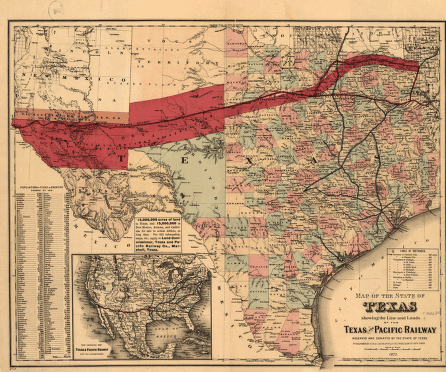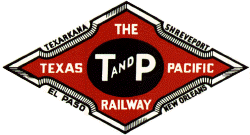A Vast and Great Empire
The Texas and Pacific Railway Company was the only railroad in Texas, and one of the few in the United States, to operate under a federal charter. Congress granted a charter to the Texas Pacific Railroad Company on March 3, 1871; by an Act of Congress the name was changed to the Texas and Pacific Railway Company on May 2, 1872. With the end of the Civil War, the project to construct a southern transcontinental railroad was revived, and the Texas Pacific was given the right to build from Marshall, Texas, to San Diego, California. The company was granted a federal land grant of twenty sections of land per mile through California and forty sections through what is now Arizona and New Mexico and a state land grant of twenty sections in Texas.
 The Texas Legislature recognized the federal charter in 1871 and authorized the Texas Pacific to purchase the Southern Trans-Continental Railway Company and the Southern Pacific Railroad Company, both previously chartered by the state. This Southern Pacific was not related to the later Southern Pacific system, which originated in California. The Texas company was originally chartered as the Texas Western Railroad Company on February 16, 1852, and the name changed to the Southern Pacific on August 16, 1856. The Southern Pacific owned a line between Longview and Waskom and leased the North Louisiana and Texas Railroad Company from the Texas state line to Shreveport. This sixty-six mile railroad was acquired by the Texas and Pacific on March 21, 1872, and was the only predecessor of the company in Texas to have built and operated a railroad. The Southern Trans-Continental, acquired March 30, 1872, and the Memphis, El Paso and Pacific Railroad Company, acquired June 12, 1873, never progressed beyond the construction phase.
The Texas Legislature recognized the federal charter in 1871 and authorized the Texas Pacific to purchase the Southern Trans-Continental Railway Company and the Southern Pacific Railroad Company, both previously chartered by the state. This Southern Pacific was not related to the later Southern Pacific system, which originated in California. The Texas company was originally chartered as the Texas Western Railroad Company on February 16, 1852, and the name changed to the Southern Pacific on August 16, 1856. The Southern Pacific owned a line between Longview and Waskom and leased the North Louisiana and Texas Railroad Company from the Texas state line to Shreveport. This sixty-six mile railroad was acquired by the Texas and Pacific on March 21, 1872, and was the only predecessor of the company in Texas to have built and operated a railroad. The Southern Trans-Continental, acquired March 30, 1872, and the Memphis, El Paso and Pacific Railroad Company, acquired June 12, 1873, never progressed beyond the construction phase.
Marshall O. Roberts was the first president of the Texas and Pacific, but was succeeded by Thomas A. Scott of Philadelphia in early 1872. Grenville M. Dodge was appointed chief engineer. Construction of the various lines was commenced by the California and Texas Railway Construction Company in October 1872, and the 125 miles between Longview and Dallas was placed in service on July 1, 1873. The seventy-four miles from Marshall to Texarkana opened for regular service on December 28, 1873, and the fifty-six miles between Sherman and Brookston was also built during this period. Work was also begun at San Diego. However, the construction company failed due to the panic of 1873, when it could not negotiate the Texas and Pacific securities it received in payment for building the railroad.
Following the cancellation of the construction contract, the Texas and Pacific resumed construction to a limited extent with its own forces. The line from Eagle Ford (Dallas) was extended to Fort Worth on July 19, 1876, and line from Brookston to Texarkana was opened for service on August 11, 1876, giving the company a total of 444 miles of line. Over the next several years the railroad attempted, without success, to finance construction of its line to the Pacific Ocean. Finally, in the fall of 1879, Jay Gould organized a syndicate to acquire an interest in and to complete the Texas and Pacific. General Dodge was again in charge of construction. With solid financial backing, work resumed in earnest. Track laying began at Fort Worth on April 1, 1880, and the rails reached Sierra Blanca on December 16, 1881. Dodge had constructed 520 miles of track west of Fort Worth, winding through twelve counties inhabited principally by Indians, prairie dogs, and coyotes. During 1880 the company also resumed construction of its Trans-Continental Division from Sherman west to Fort Worth, ninety miles, which was placed in service on May 9, 1881. By the end of 1881 the Texas and Pacific had 1,034 miles of main track in Texas. In the meantime, the California-based Southern Pacific Railroad Company had constructed a line to the Colorado River across from Yuma, Arizona Territory, where it was to meet the Texas and Pacific. However, Collis P. Huntington and his associates decided not to wait and continued to build eastward, reaching El Paso in May 1881. They had acquired an interest in the Galveston, Harrisburg and San Antonio Railway Company and, under its charter, reached Sierra Blanca ahead of the Texas and Pacific. In its construction east from Yuma, the Southern Pacific occupied the line surveyed and designated by the Texas and Pacific as its right-of-way. This resulted in suits being filed against the Southern Pacific by the Texas and Pacific for possession of the line between El Paso and Yuma. The dispute was settled by the "Gould-Huntington Agreement" of November 26, 1881. Under terms of this agreement the Texas and Pacific was to build no further than Sierra Blanca, ninety-two miles east of El Paso. The two systems would use the line to El Paso jointly, forming one continuous line to the coast. The Texas and Pacific relinquished its property rights and franchises west of El Paso to the Southern Pacific. The agreement also provided for pooling, harmonious operation, and for the cooperation in the building of new lines. All of the provisions except that for the joint trackage have been nullified by subsequent laws. The Texas and Pacific later unsuccessfully tried in the courts and before the Interstate Commerce Commission to secure a one-half interest in the joint track.
From 1873 to 1881 the Texas and Pacific had constructed 972 miles of track and was entitled to 12,441,600 acres of land. The company actually received land only for the construction east of Fort Worth, totaling 5,173,120 acres. It received no land for the trackage west of Fort Worth on the grounds that it was not completed within the time stipulated in the charter. In 1891 Attorney General Charles A. Culberson filed suit for recovery of 301,893 acres on the ground that the road had been granted land partly on sidetracks and partly on land not subject to location. The state recovered 256,046 acres. The Interstate Commerce Commission found that the road had realized about $3.00 per acre, or $15,621,881 on its 4,972,974 acres of state land. The Texas and Pacific acquired several lines in Louisiana and on September 12, 1882, completed a through route from Shreveport to New Orleans. In 1898 the company built its own line from Waskom on the Texas Louisiana border to Shreveport and relinquished the leased trackage between the two points that it had used since 1862. The only branch constructed by the Texas and Pacific in Texas during this period was the six miles between Mingus and the coal mines at Thurber, which was built in 1888. However, the road was active in acquiring or financing the construction of short lines to serve as feeders. These included the Denison and Pacific Suburban Railway Company, which was acquired in 1895, and the Weatherford, Mineral Wells and Northwestern Railway Company, acquired in 1903. In 1927 the Texas and Pacific acquired the Cisco and Northeastern, the Abilene and Southern, and the Pecos Valley Southern Railway companies. In 1928 the Texas-New Mexico Railway Company was organized to build from Monahans to Lovington, New Mexico, and in 1929 the Texas Short Line Railway Company was purchased. The Texas and Pacific acquired a 60 percent interest in the Fort Worth Belt Railway Company in 1932. All of the short line railroads maintained their separate corporate identities. The Texas and Pacific also owned a one-eighth interest in the Union Terminal Company at Dallas and a one-sixth interest in the El Paso Union Passenger Depot Company.
In 1931 the Texas and Pacific owned 365 locomotives, 236 passenger cars, and 9,816 freight cars, and earned $24,000,000 in freight revenue, $3,282,000 in passenger revenue, and other revenue of $2,721,000. The discovery of oil along the Texas and Pacific line in West Texas during the late 1920s and later in East Texas had a major impact on the company. In 1928 crude oil accounted for 22 percent of all freight tonnage. During the years of peak crude oil movement the physical condition of the railroad was significantly improved, and the Texas and Pacific was able to weather the Great Depression better than many of the other railroads in its region. Other than the abandonment of the Cisco and Northeastern on March 9, 1942, and the sale of the Pecos Valley Southern on November 30, 1946, there was little change in the mileage of the Texas and Pacific until the 1960s. The Texas Short Line was abandoned on March 7, 1962. In September 1964 the company acquired control of three associated companies based in Oklahoma, the Kansas, Oklahoma and Gulf Railway Company, the Midland Valley Railroad Company, and the Oklahoma City-Ada-Atoka Railway Company. The Oklahoma City-Ada-Atoka was resold to the Atchison, Topeka and Santa Fe Railway Company, and the Midland Valley was merged on April 1, 1967, and the Kansas, Oklahoma and Gulf on April 1, 1970. With the acquisition of trackage rights over the Missouri-Kansas-Texas Railroad Company between Denison and Whitesboro, the Denison and Pacific Suburban became surplus and authority to abandon this line was obtained on April 2, 1965. In 1968 the Texas and Pacific constructed twenty-nine miles of track from San Martine to Rockhouse and the next year acquired nine miles from Fort Worth to Everman from the Missouri Pacific Railroad Company.
Between 1881 and 1885, when the railroad entered receivership, the Texas and Pacific was leased to the Missouri Pacific Railway Company. Following the cancellation of the lease, the Texas and Pacific and the Missouri Pacific continued to work together as a system through Gould holdings in both companies. With the 1917 reorganization of the Missouri Pacific, Gould interests no longer controlled the two railroads. The following year the new Missouri Pacific Railroad Company began to formalize its relationship with the Texas and Pacific by buying stock in the Texas line. By 1930 the Missouri Pacific owned enough Texas and Pacific stock to give it nearly 75 percent ownership; the Missouri Pacific continued to increase its interest so that by the end of 1974 it owned nearly 97 percent of the stock. In that year the Texas and Pacific owned 1,982 miles of main track in Texas, Louisiana, Oklahoma, and Arkansas. Of the total, 1,109 miles were in Texas. The railroad also owned a total of 153 diesel units and 3,629 freight cars. Freight revenues in 1974 were $149,073,000. In addition, the Texas and Pacific continued to control the Abilene and Southern, Fort Worth Belt, Texas-New Mexico, and Weatherford, Mineral Wells and Northwestern. On October 15, 1976, the Texas and Pacific was merged into the Missouri Pacific.
George C. Werner
"TEXAS AND PACIFIC RAILWAY." The Handbook of Texas Online.





 History of the T&P
History of the T&P


